
The Battle of Okinawa, codenamed Operation Iceberg, was a major battle of the Pacific War fought on the island of Okinawa by United States Army and United States Marine Corps forces against the Imperial Japanese Army. The initial invasion of Okinawa on April 1, 1945 was the largest amphibious assault in the Pacific Theater of World War II. The Kerama Islands surrounding Okinawa were preemptively captured on March 26 by the 77th Infantry Division. The 82-day battle on Okinawa itself lasted from April 1, 1945 until June 22, 1945. After a long campaign of island hopping, the Allies were planning to use Kadena Air Base on the island as a staging point for Operation Downfall, the planned invasion of the Japanese home islands, 340 mi (550 km) away.

Okinawa Prefecture is the southernmost and westernmost prefecture of Japan. It has a population of 1,457,162 and a geographic area of 2,281 km2.

The United States Forces Japan (USFJ) is a subordinate unified command of the United States Indo-Pacific Command. It was activated at Fuchū Air Station in Tokyo, Japan, on 1 July 1957 to replace the Far East Command. USFJ is headquartered at Yokota Air Base in Tokyo and is commanded by the Commander, US Forces Japan who is also commander of the Fifth Air Force. Since then, it is the first and only sustained presence of a foreign military on Japanese soil in its history.
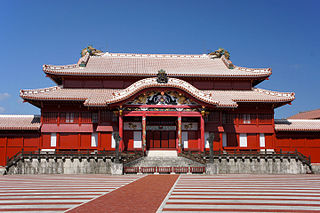
This article is about the history of the Ryukyu Islands, located southwest of the main islands of Japan.
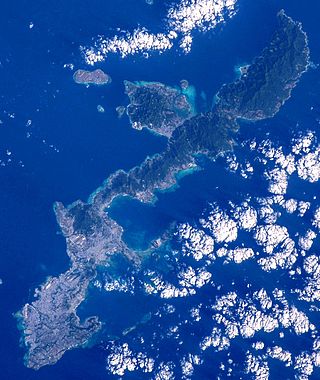
Okinawa Island, officially Okinawa Main Island, is the largest of the Okinawa Islands and the Ryukyu (Nansei) Islands of Japan in the Kyushu region. It is the smallest and least populated of the five main islands of Japan. The island is approximately 106 kilometres (66 mi) long, an average 11 kilometres (7 mi) wide, and has an area of 1,206.98 square kilometers (466.02 sq mi). It is roughly 640 kilometres south of the main island of Kyushu and the rest of Japan. It is 500 km northeast of Taiwan. The total population of Okinawa Island is 1,384,762. The greater Naha area has roughly 800,000 residents, while the city itself has about 320,000 people. Naha is the seat of Okinawa Prefecture on the southwestern part of Okinawa Island. Okinawa has a humid subtropical climate.

Marine Corps Air Station Futenma or MCAS FutenmaA is a United States Marine Corps base located in Ginowan, Okinawa, Japan, 5 NM northeastB of Naha, on the island of Okinawa. It is home to approximately 3,000 Marines of the 1st Marine Aircraft Wing and other units, and has been a U.S. military airbase since the defeat of the Japanese Imperial Army in the Battle of Okinawa in 1945. Marine Corps pilots and aircrew are assigned to the base for training and providing air support to other land and sea-based Marines in Okinawa and throughout the Asia-Pacific region. MCAS Futenma is part of the Marine Corps Installations Pacific command.

Camp Foster, formerly known as Camp Zukeran, is a United States Marine Corps camp located in Ginowan City with portions overlapping into Okinawa City, Chatan town and Kitanakagusuku village in the Japanese prefecture of Okinawa Island. It is part of the Marine Corps Base Camp Smedley D. Butler complex.
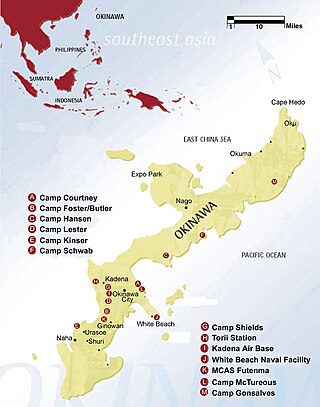
The Special Action Committee on Okinawa is a formal agreement made between the United States Government and the Government of Japan.
National Route 58 is a Japanese national highway connecting the capital cities Kagoshima and Naha of Kagoshima Prefecture and Okinawa Prefecture, respectively. With a total length of 884.4 kilometers (549.5 mi), it is the longest national highway in Japan, though it measures only 245.2 kilometers (152.4 mi) on land. The highway begins at an intersection with National Routes 3 and 10 in Kagoshima. From Kagoshima, it travels southwest along the first island chain that divides the Pacific Ocean from the East China Sea. From the north to the south, it has sections on the islands of Tanegashima, Amami Ōshima, and finally, Okinawa. On Okinawa it ends at an intersection with National Routes 330, 331, and 390 in Naha.

U.S.–Japan Status of Forces Agreement is an agreement between Japan and the United States signed on 19 January 1960 in Washington, the same day as the revised U.S.-Japan Security Treaty. It is a status of forces agreement (SOFA) as stipulated in article VI of that treaty, which referred to "a separate agreement" governing the "use of [...] facilities and areas [granted to the U.S.] as well as the status of United States armed forces in Japan". It replaced the earlier "U.S.-Japan Administrative Agreement" that governed such issues under the original 1951 security treaty. The privileges of USFJ are effectively kept with the "Agreed Minutes To The Agreement Under Article VI Of The Treaty Of Mutual Cooperation And Security Between Japan And The United States Of America, Regarding Facilities And Areas And The Status Of United States Armed Forces In Japan" and other arrangements.
The 1995 Okinawa rape incident occurred on September 4, 1995, when three U.S. servicemen, 22-year-old U.S. Navy Seaman Marcus Gill, 21-year-old U.S. Marines Rodrico Harp, and 20-year-old Kendrick Ledet, all serving at Camp Hansen on Okinawa, rented a van and kidnapped a 12-year-old Okinawan girl. They beat her, duct-taped her eyes and mouth shut, and bound her hands. Gill and Harp then raped her, while Ledet claimed he only pretended to do so due to fear of Gill.
On November 2, 2002, U.S. Marine Corps Major Michael Brown attempted an indecent assault on a Filipina bartender in Okinawa, Japan. The bartender accused Brown of attempting to rape her and of throwing her cell phone into a nearby river; Brown denied the rape charges. The victim later recanted and attempted to withdraw the accusation, though prosecutors presented evidence that she had received a cash payment just before doing so.
Tatsuhiro Ōshiro was an Okinawan novelist and playwright from Okinawa, Ryukyu Islands.
The 1996 Padilla car crash occurred in Okinawa, Japan, on 7 January 1996. Lori Padilla, a member of the United States Marine Corps in Okinawa, was speeding in a car which swerved off the road, killing Rojita Kinjo and her young daughters Mitsuko and Mariko. The crash sparked outrage in Okinawa and strengthened opposition to the U.S. military presence in Japan, which was already facing scrutiny over the 1995 Okinawan rape incident that occurred only a few months earlier.
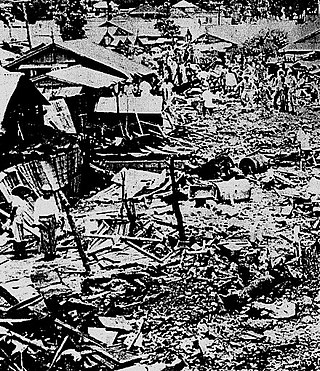
The 1959 Okinawa F-100 crash, also known as the Miyamori Elementary School crash (宮森小学校米軍機墜落事故), occurred on June 30, 1959, when a North American F-100 Super Sabre of the United States Air Force crashed in Ishikawa, in United States-occupied Okinawa, killing 18 people.
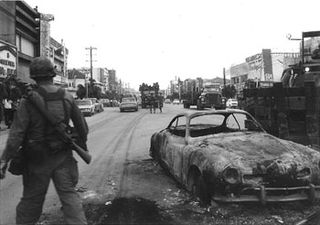
The Koza riot was a violent and spontaneous protest against the US military presence in Okinawa, which occurred on the night of December 20, 1970, into the morning of the following day. Roughly 5,000 Okinawans clashed with roughly 700 American MPs in an event which has been regarded as symbolic of Okinawan anger against 25 years of US military administration. In the riot, approximately 60 Americans and 27 Okinawans were injured, 80 cars were burned, and several buildings on Kadena Air Base were destroyed or heavily damaged.
Allied and Japanese troops committed a number of rapes during the Battle of Okinawa during the last months of the Pacific War and the subsequent Allied occupation of Japan. The Allies occupied Japan until 1952 following the end of World War II and Okinawa Prefecture remained under US governance for two decades after.
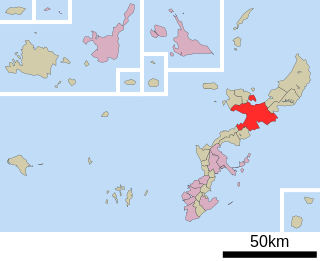
The 1945 Katsuyama killing incident was the killing of three African-American United States Marines in Katsuyama near Nago, Okinawa after the Battle of Okinawa on July 10, 1945, to August 13, 1946. Residents of Katsuyama had reportedly killed the three Marines for their repeated rape of village women during occupation of Okinawa and hid their bodies in a nearby cave out of fear for retaliation. The Katsuyama incident was kept secret until August 16, 1997, when the bodies and identities of the Marines were discovered.

The Yumiko-chan incident was the rape and murder of five-year-old Japanese girl Yumiko Nagayama, sometimes reported as Yumiko Arakaki, by U.S. soldier Sergeant Isaac J. Hurt in Kadena, Okinawa, on September 4, 1955. Nagayama's body was found near Kadena Air Base during the U.S. occupation of Okinawa. An investigation led to the conviction of 31-year-old Sergeant Hurt on charges of murder, rape, and kidnapping. The Yumiko-chan incident caused anti-American outrage in Okinawa and contributed to the first major Okinawan protests against the U.S. occupation and military presence.

The main island of Okinawa accounts for 0.6% of Japan's land mass, though about 75% of United States forces in Japan are stationed in the Okinawa prefecture, encompassing about 18% of the main island of Okinawa. Following the ratification of the revised U.S.-Japan Security Treaty in 1960, massive protests of US military presence in Okinawa followed across Japan with an estimated 30 million Japanese citizens participating, known in Japan as the Anpo protest movement. With such a strong focus of United States Forces Japan in Okinawa, residents face economic problems of the highest unemployment in Japan as well as struggle for investment from outside businesses. Immense public opposition in Okinawa is still met with difficulty to create change for Okinawan citizens, while 25,000 American troops remain in Okinawa.














